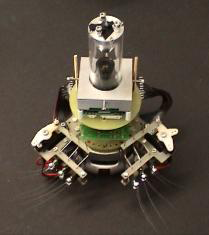
source: M. Fend
As part of the Artificial Mouse (AMOUSE) Project, researchers from the Artificial Intelligence Laboratory at the University of Zurich have developed a robotic mouse, the AMouse, that navigates by means of an omnidirectional camera, several light sensors, and two active artificial whisker arrays. In nature, vibrissae, better known as whiskers, are important sensors for short-range navigation and environmental exploration. The goal of the research is to learn more about the biology and neurology of rodent behavior and to study the way that the input from long and medium range sensors like the camera and light detectors function with and compliment the short range, somatosensory input provided by the whiskers.
The robot’s two whisker arrays consist of real rat whiskers connected to a capacitor microphone that is able to measure the high-frequency movements of the whiskers. When the whisker comes in contact with an external object like a wall, it deforms, resulting in a voltage signal change that is measured by the microphone. Although the whiskers on a real mouse move in two dimensions, the capacitor microphone configuration only allows for measurement in one dimension. So the robot sweeps its whiskers back and forth, and its sensors can measure changes in this frequency very well, but they are not able to measure any deflection. For these early studies it was determined this behavior was similar enough to biological rats and mice that it was not a limitation.
For the actual experiments the robot was given a simple set of behaviors that governed its movement. If there is no other influence, move forward. If a light source is detected, move towards the light. If a collision with an object is eminent, change direction to avoid the object. The final rule, obstacle avoidance, held priority over the first two. If an object was detected, the robot’s primary goal was to navigate around it. Similarly, the light-seeking rule had priority over the default move forward behavior.
Once the scientists were able to settle on a light source strong enough to influence the robot’s sensors, the robot successfully completed a series of runs through a small area containing obstacles by using its light sensors to follow the light reflected off of several surfaces and by using its whiskers to avoid the obstacles.
Although this series of experiments involved no learning, their next goal is to begin to model place cell navigation. Place cells are a type of neuron found in the hippocampus that fire when an animal is in a specific location in an environment. They have already been well studied in rats. Additionally, the researchers would like to study how visual and somatosensory inputs can be combined for not only navigation, but for the classification of textures and shapes as well.
Thanks to Technovelgy.com for bringing this work to my attention with their summary today.
